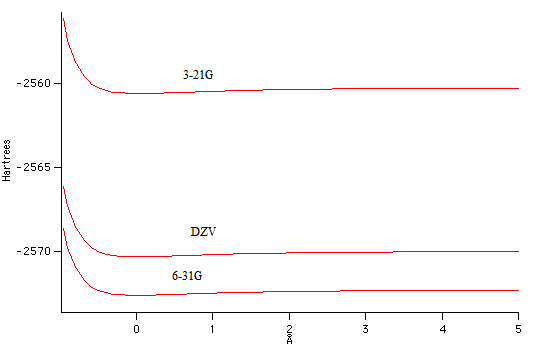| Number of diffuse orbital functions included in basis set | 3-21G | 6-31G | DZV |
| 0 | 1.322598 | 1.429702 | 1.500531 |
| 3 | failure | 1.146224 | 1.0979278 |
| 5 | failure | 0.978147 | 0.951230 |
| 7 | failure | 0.951641 | 0.970366 |
Table 2 - Dipole moments, Debye.
Literature Value: 0.827 DebyeThe failures of the 3-21G basis set can likely be attributed to the insufficient size of the set. There is a general trend of more diffuse functions leading to more accurate results, with the exception of the DZV with 7 difuse functions. This is another example of how care must be taken when performing these calculations.
UV VIS data
| 3-21G | 6-31G | DZV | Literature |
| 62460.53 | 62625.91 | 61888.18 | 2500 |
| 113392.79 | 110478.65 | 110387.62 | |
| 194016.17 | 117185.39 | 169565.38 | |
| 194281.11 | 129661.68 | 171294.34 | |
| 197612.77 | 133333.86 | 171821.6 | |
| 198249.03 | 133687.31 | 178705.02 | |
| 202884.99 |
Table 3 - ultraviolet visual range electronic transition frequencies, cm^-1.
Below
is a graph of potential energy vs. bond stretch. In general it is
accepted that the larger the basis set, the lower the calculated energy
will be. However, these results are an exception to that trend,
as the DZV set is larger than the 6-31G set. Heavier atoms are
harder to deal with in computations, and this result may be explained
by an inability to accurately compute the properties of bromine.

Figure
3 - Graph of potential energy vs. bond stretch. The larger basis
set DZV calculated a higher energy than the 6-31G basis set, which is
contrary to the expectation that larger basis sets produce lower
energies.
Below is a table of vibrational frequencies for HBr.
| 3-21G | 6-31G | DZV | Literature |
| 2491 | 2672 | 2654.5 | 2649 |
| 14.01 | 2505 | ||
| 13.55 | |||
| 4.17 |
Table 4 - Vibrational frequencies, cm^-1. Each basis set came close to the literature value of 2649,
with the largest basis set DZV coming the closest in this instance.
with the largest basis set DZV coming the closest in this instance.